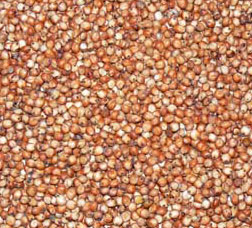


Ferulic, p-coumaric, isoferulic, and p-hydroxybenzoic acids were found in the red sorghum, with ferulic acid as the predominant phenolic acid and mostly in an insoluble bound form. The extract had scavenging capacities against DPPH, ABTS +, and peroxyl radicals and suppressed LPS stimulated IL-1β, IL-6, and COX-2 mRNA expressions in a dose-dependent manner. Moreover, acetone–water (60:40, v/v) extract of the red sorghum exhibited the greatest total phenolic content of 2.77 mg GAE/g and total flavonoid content of 5.44 mg RE/g. β-Carotene was the primary carotenoid at a level of 26.14 μg/g. Linoleic and oleic acids were the primary fatty acids, contributing more than 80% of the total fatty acids.


A total of 17 TAGs were identified in the red sorghum oil. 1) was investigated for its triacylglycerol (TAG) and fatty acid profiles, carotenoid and tocopherol compositions, total phenolic, total flavonoid and phenolic acid contents, and antioxidant and anti-inflammatory properties. Its curiosity in regard to the cultural specificities found in this foreign culture.In this study, a new red sorghum variety (Ji Liang No. We suggest that an awareness of register variables results in a more appropriateĬommunication of the Chinese cultural context, and is therefore more likely to be viewed positively by the Arab audience, piquing This approach will be illustrated through a number of examples representative of manyĮxamples translated and assessed by the authors. For this reason, this study offers alternative translation techniques into Arabic that foreground the author’s style Results in the misrepresentation of Chinese cultural experience as well as an absence of evaluative meanings at an interpersonal Wider socio-cultural framework, the paper concludes that the original translation of the novel is not successful, as it lacks anĪwareness of register characterization which plays an important part in the translation-oriented analysis of literary texts. Relying on textual analysis that relates to a Translation studies specifically in regard to scholarship concerning translation between Chinese and Arabic, and it attempts toĪdd additional literature for Chinese-Arabic translators or translator trainees. Propose additional solutions for the translation of Chinese literature into Arabic. By comparing the Chinese source text with the Arabic target text, this paper aims to present anĪssessment of the Arabic translation based on an awareness of translation theory and, in particular, translation qualityĪssessment or what is widely known as register analysis ( House 1997) in order to The Chinese novel Hóng Gāoliáng Jiāzú ( 红高粱家族, Red Sorghum 2008) was written by the Nobel-winning Chinese writer Mò Yán ( 莫言).


 0 kommentar(er)
0 kommentar(er)
